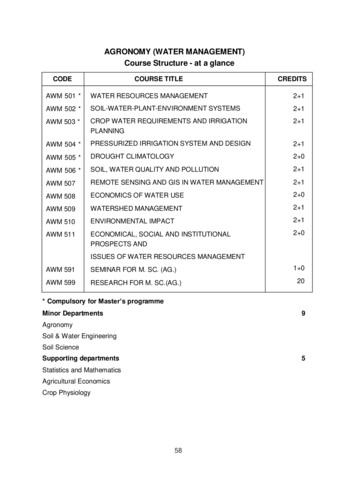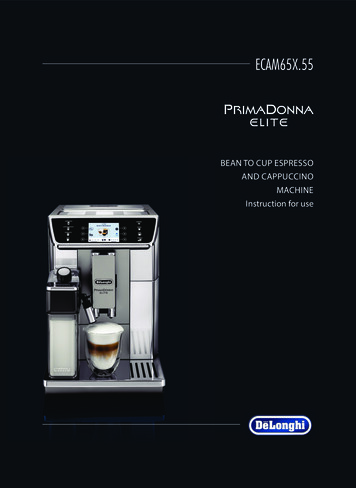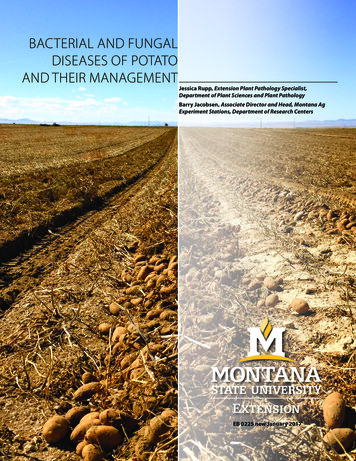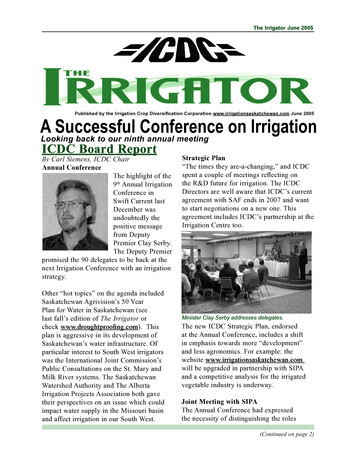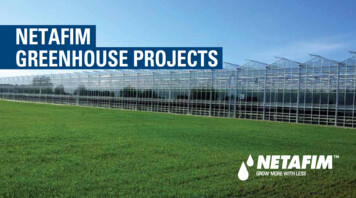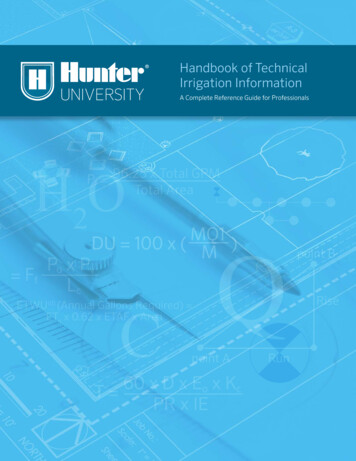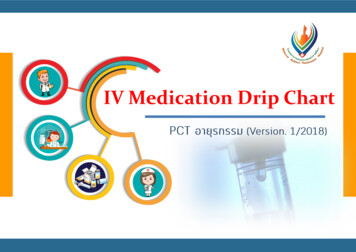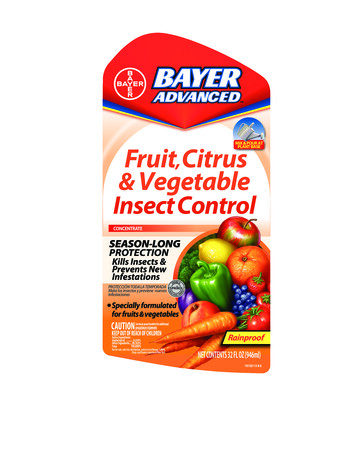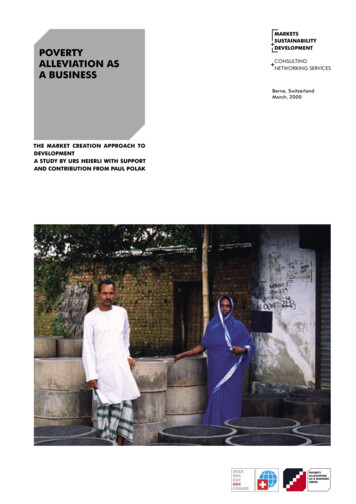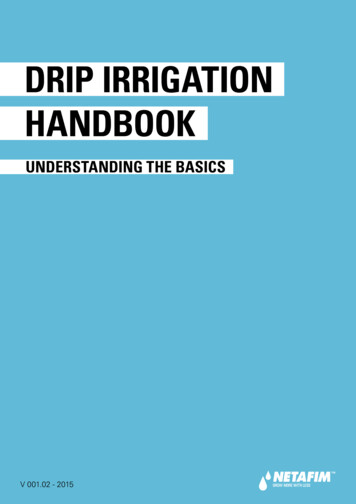
Transcription
DRIP IRRIGATIONHANDBOOKUNDERSTANDING THE BASICSV 001.02 - 2015
COPYRIGHT 2013, NETAFIM NO PART OF THIS PUBLICATION MAY BE REPRODUCED, STORED IN AN AUTOMATED DATA FILE OR MADE PUBLIC INANY FORM OR BY ANY MEANS, WHETHER ELECTRONIC, MECHANICAL, BY PHOTOCOPYING, RECORDING OR IN ANYOTHER MANNER WITHOUT PRIOR WRITTEN PERMISSION OF NETAFIM .THIS DOCUMENT IS PRESENTED WITH THE EXCLUSIVE AIM OF NOTIFYING SELECTED POTENTIAL CLIENTS REGARDINGTHE NETAFIM DRIP IRRIGATION SYSTEM. RECEIPT OR THE POSSESSION OF THIS DOCUMENT DOES NOT IMPLYRIGHTS AND THE CONTENTS SHOULD BE VIEWED AS A PROPOSAL ONLY. THIS DOCUMENT IS NEITHER ISSUED AS AGUARANTEE, NOR IS IT LEGALLY BINDING.NETAFIM ENDEAVORS TO PROVIDE QUALITY, ACCURATE AND DETAILED INFORMATION. NEVERTHELESS, NETAFIM CANNOT ACCEPT ANY RESPONSIBILITY FOR RELIANCE ON THE INFORMATION PROVIDED, AND THE USER IS ADVISEDTO INDEPENDENTLY OBTAIN THE PROFESSIONAL ADVICE OF NETAFIM AND/OR ITS AUTHORIZED REPRESENTATIVES.THERE IS NO UNDERTAKING BY NETAFIM THAT THE PROVIDED INFORMATION OR ANY PART THEREOF IS ACCURATE,COMPLETE OR UP TO DATE.MENTION OF THIRD-PARTY PRODUCTS IS FOR INFORMATIONAL PURPOSES ONLY AND CONSTITUTES NEITHER ANENDORSEMENT NOR A RECOMMENDATION. NETAFIM DOES NOT ASSUME ANY RESPONSIBILITY WITH RESPECT TOTHE USE OR THE PROVISIONS OF SUCH PRODUCTS.NETAFIM WILL NOT ACCEPT RESPONSIBILITY FOR DAMAGE OR LOSS THAT MAY RESULT FROM THE USE OFNETAFIM'S PRODUCTS OR THE USE OF THIS DOCUMENT.NETAFIM RESERVES THE RIGHT TO MAKE CHANGES AND IMPROVEMENTS TO ITS PRODUCTS AND/OR THEASSOCIATED DOCUMENTATION WITHOUT PRIOR NOTICE.FOREIGN LANGUAGESIn the event that you are reading this manual in a language other than the English language, youacknowledge and agree that the English language version shall prevail in case of inconsistency orcontradiction in interpretation or translation.
CONTENTSIntroduction456Aim of this documentSafety instructionsUse of symbols in this documentDrip irrigation system overview7An overview of the drip irrigation system components, their functions and properties:Structure of a drip irrigation system; Water source; Pumps & pumping stations; Filtration;Main, sub-main, distribution pipes and fittings; Water meters and pressure gauges; Valves;Dosing unit; Dripperlines (laterals); Connectors; End of dripperlines; Sensors; Controller;Accessories and add-ons; Agro-machinery.Drip irrigation management and operation47Guidelines and useful tips for the proper management and operation of a drip irrigation system:Irrigation; Nutrigation ; Nutrigation via a drip irrigation system; Chemigation;Dripperline insertion or laying.Drip irrigation system maintenance65Guidelines and useful tips for the proper maintenance of a drip irrigation system:Maintenance timetable; System flushing; Preparation and use of a hydraulic conditions checklist;Chemical injection for system maintenance; Water analysis; Sampling drippers;Rodent control; Root intrusion prevention in subsurface drip irrigation (SDI) systems;Contamination from external particles in SDI; Periods of system inactivity.Water / soil / plant relationship83Vital information considering the soil condition, the water characteristics and the needs of thecrop, and guidelines for the planning and management of a drip irrigation system:Soil; Water budgeting; TensiometersAppendicesAppendix 1: Unit conversion tablesAppendix 2: Further reading9495DRIP IRRIGATION HANDBOOK 3
INTRODUCTIONIrrigation is the watering of land by artificial methods. Without irrigation, agriculture is limited by theavailability and reliability of naturally occurring water from floods or rain.Drip irrigation is widely accepted as the most efficient irrigation technique as it allows high uniformity ofwater and nutrient application.Aim of this documentThis document's purpose is to present the basic concepts regarding drip irrigation, to familiarize the readerwith the components of a drip irrigation system and their functions, and to provide understanding of thebasic operational and maintenance issues regarding the system.It is intended for Netafim's personnel and its representatives and agents all over the globe, and for itsclients, their decision makers, managers and operational personnel.The importance of thorough knowledge of the subjects discussed in this document for the effectiveoperation and maintenance of the drip irrigation system cannot be overemphasized.Drip irrigation is the most advanced and the most efficient of all irrigation methods. However, itsexceptional capabilities cannot be effectively implemented if the user is not familiar with the relatedknowledge and does not implement it in the current operation and maintenance of the drip irrigationsystem.Netafim makes every effort to provide its clients all over the globe with concise, comprehensibledocumentation with the intent to facilitate the operation and maintenance of the drip irrigation systemwhile maximizing the ensuing benefits - higher yield of superior quality crop with higher market value andshorter ROI.Netafim's personnel and its representatives and agents all over the globe should make sure to read andunderstand this entire document thoroughly prior to advising their clients on issues regarding the purchase,installation, operation and maintenance of a Netafim drip irrigation system.It is the responsibility of Netafim's representatives and agents to make sure that, prior to purchase, theclient's decision makers are familiar with the installation, operational and maintenance considerationsregarding a drip irrigation system, as discussed in this document.The clients' managers and operational personnel should be familiar with the components of a drip irrigationsystem and their functions, and study in depth all the operational and maintenance issues discussed in thisdocument prior to first operation of a new Netafim drip irrigation system.ATTENTIONThis document is not a user manual. For detailed instructions for the operation, maintenanceand troubleshooting of the components of the Netafim drip irrigation system, reffer to the usermanuals and documentation of each component supplied with the system.This document should be kept available to the farm's personnel at any time for consultation on issuesregarding the current operation and maintenance of the drip irrigation system.In addition, Netafim's irrigation products department is at the client's service for any inquiry, advice oradditional information needed after reading this document.4 DRIP IRRIGATION HANDBOOK
INTRODUCTIONSafety instructionsAll local safety regulations must be applied when installing, operating, maintaining and troubleshooting theNetafim drip irrigation system and its components.WARNINGIn an agricultural environment - always wear protective footwear.WARNINGOnly authorized electricians are permitted to perform electrical installations!Electrical installations must comply with the local safety standards and regulations.WARNINGMeasures must be taken to prevent the infiltration of nutrients, acids and chemicals into the watersource.ACID HAZARDWhen not handled properly, nutrients, acids and chemicals may cause serious injury or even death.They may also damage the crop, the soil, the environment and the irrigation system.Proper handling of nutrients, acids and chemicals is the responsibility of the grower.Always observe the nutrient/acid/chemical manufacturer's instructions and the regulations issuedby the relevant local authority.WARNINGWhen handling nutrients, acids and chemicals, always use protective equipment,gloves and goggles.CAUTIONWhen opening or closing any manual valve, always do so gradually, to prevent damage to thesystem by water hammer.DRIP IRRIGATION HANDBOOK 5
INTRODUCTIONThe symbols used in this document refer to the following:WARNINGThe following text contains instructions aimed at preventing bodily injury or direct damage to thecrops and/or the irrigation system.CAUTIONThe following text contains instructions aimed at preventing unwanted system operation,installation or conditions. Failure to followthese instructions might void the warranty.ATTENTIONThe following text contains instructions aimed at enhancing the efficiency of usage of theinstructions in the document.NOTEThe following text contains instructions aimed at emphasizing a certain aspect of the operationor installation of the system.ACID HAZARDThe following text contains instructions aimed at preventing bodily injury or direct damage to thecrops and/or the irrigation system in the presence of acid.ELECTRICAL HAZARDThe following text contains instructions aimed at preventing bodily injury or direct damage to theirrigation system components in the presence of electricity.SAFETY FOOTWEARThe following text contains instructions aimed at preventing foot injury.PROTECTIVE EQUIPMENTThe following text contains instructions aimed at preventing damage to health or bodilyinjury in the presence of nutrients, acid or chemicals.EXAMPLEThe following text provides an example to clarify the operation of the settings, method ofoperation or installation.The values used in the examples are hypothetical. Do not apply these values to your ownsituation.TIPThe following text provides clarification, tips or useful information.6 DRIP IRRIGATION HANDBOOK
DRIP IRRIGATIONSYSTEMOVERVIEWStructure of a drip irrigation system8Water source10Pumps & pumping stations10Filtration14Main, sub-main, distribution pipes and fittings20Water meters and pressure gauges22Valves24Dosing unit26Dripperlines (laterals)31Connectors36End of dripperlines37Sensors39Controller41Accessories and add-ons43Agro-machinery44DRIP IRRIGATION HANDBOOK 7
DRIP IRRIGATION SYSTEM OVERVIEWA drip irrigation system comprises many components, each one of them playing an important part in theoperation of the system.The aim of this chapter is to provide an overview of the drip irrigation system components, their functionsand properties.Structure of the drip irrigation systemSystem headPlot headPlot headSystem headPlot head8 DRIP IRRIGATION HANDBOOK
DRIP IRRIGATION SYSTEM OVERVIEWSchematic diagramWater sourceMain filtration automatic drainage valveSub main linePumping stationWater meterDistribution lineAir valveHydraulic valveKinetic valve (vacuum breaker)Pressure gaugeSecondary filtration unitDripperlineCheck valveDosing unitFlushing valveShock absorberFertilizer tankFlushing manifoldManual valveIrrigation controllerFertilizer filterMain filtration unitMain lineDRIP IRRIGATION HANDBOOK 9
DRIP IRRIGATION SYSTEM OVERVIEWWater sourceThere are basically two main types of water sources: groundwater and surface water:Many existing and potential water supply sources for irrigation systems are derived from surface water,which does not tend to have high levels of salts (with the exception of some coastal areas), and thussystems are usually less prone to formation of precipitates in drippers when using a surface water source.Surface water, however, tends to introduce biological hazards. If wastewater is being considered as asource, quality and clogging potential will vary depending upon the extent of treatment.Groundwater is generally of higher quality than surface water. However, iron and manganese levels shouldbe measured, as high levels may lead to dripper clogging, and treatment may be required.Pumps & pumping stationsUnless the water at the source is supplied at an adequate flow rate and pressure (by municipal or otherentity supply, a pre-existing pump upstream from the irrigation system or gravitational pressure*), a pumpwill be needed to push water from the source through the pipes and drippers.Most irrigation systems include pumps as an integral part of the drip irrigation system.*Gravitational pressure (also known as hydrostatic pressure) is the pressure at a point in a fluid at restdue to the weight of the fluid above it. If the water source is at a higher elevation than the drippers in thefield, the elevation difference between them will determine the gravitational pressure in the system(e.g. the water level in a tank is 5 meters above the elevation of the pump's axis, the gravitational pressureis 5 meters 0.5 bar 7.25 PSI).Selecting a pump for an irrigation system requires an understanding of the water conditions and localsystem requirements.Poor pump selection can lead to high operating costs and shortened pump life; this in turn impacts on theperformance and reliability of the whole irrigation system.When a pump site is selected it is necessary to consider a range of factors, including availability of power,proximity to the development site and water quality issues.Power source for the pumpThe power source for the pump will depend on the availability and accessibility of the energy resource inthe local area.In most instances, electricity is preferred because of reduced labor requirements and higher efficiency,resulting in lower energy cost. Three-phase power is usually required to operate over 10 horsepower (hp)irrigation pumps.If electricity is not available, alternative power sources such as diesel, gasoline, or solar may be used. Themost common alternatives are gasoline engines for small pumps and diesel engines for larger pumps.10 DRIP IRRIGATION HANDBOOK
DRIP IRRIGATION SYSTEM OVERVIEWPump typesIn most irrigation applications, centrifugal pumps are used.A centrifugal pump is a rotodynamic pump that adds energy to the water using a rotating impeller. It maybe either horizontal-shaft or vertical-shaft (including submersed pumps).Horizontal pumps are more frequently used to pump water from surface sources such as ponds.Horizontal-shaft pumpVertical-shaft pumpVertical-shaft submersed pumpPump capacityWhen selecting a pump, four basicfactors must be considered: Pump discharge (flow rate) defines the quantity of water supplied by the pump during 1 time unit(units: m3 /hour, liter/second or gallons/hour). Pressure (pressure head) defines the internal energy of a fluid due to the pressureexerted on its container's walls (also known as static pressure head or static head)(units: bar or psi. 1 bar 14.5 psi). Net Positive Suction Head (NPSH) is the required head value (suction lift) atthe inlet of a horizontal pump enabling it to pull water upwards while keepingthe water from cavitating* (inherently limited to 0.8 bar net).NPSH*Cavitation - The formation of vapor cavities ("bubbles" or "voids") in a liquid.It usually occurs when a liquid is subjected to rapid changes of pressure thatcause the formation of cavities where the pressure is relatively low. Whensubjected to higher pressure, the voids implode and can generate an intenseshockwave causing significant damage to the pump's impeller and chamber. Friction head - Head loss caused by the frictionbetween the fluid and the inner walls of the shaftenclosure of a vertical pump (or in the outlet pipeof a vertical submersed pump) which pulls thewater upwards. Friction loss increases with runlength and by the square of the fluid velocity.It affects the required pressure and flow rate.FrictionheadFrictionheadDRIP IRRIGATION HANDBOOK 11
DRIP IRRIGATION SYSTEM OVERVIEWThe output pressure of a pump is dependent on pressure head and flow rate (a higher flow rate causes alower pressure and vice versa, all other variables being unchanged).Make sure the pump is able to deliver adequate flow rate and pressure for the application. Obtain aperformance curve for the pump and have modifications made if it is not adequate - the energy savingsalone will easily pay for any upgrades required, which will also improve system operation and cropproduction, resulting in a shorter ROI.Pump selectionThe irrigation system design will specify the required pump duty (flow rate and pressure head).The best pump choice is the pump in which the Best Operating Point (BOP) occurs at this flow rate andpressure head and that can operate at the available suction head.CAUTIONThe farther the pump's Operating Point is from the BOP, the higher the operating costs, the lowerthe efficiency and the shorter the life expectancy of the pump.Main considerations: How the pump is to be installed and what the suction lift will be (see page 11). The performance required in terms of flow rate and pressure head.ConstraintsPump operating constraints may affect the supply of water and must be considered for effective planning.Common constraints include: Energy constraints that do not enable operation of the pump during certain hours of the day. Economic constraints that prevent the pump from being operated due to prohibitively high costs ofelectricity at certain times (days of the week or hours during the day). Time constraints where the water source may be unavailable at certain times or days of the week due tothe sharing of resources amongst different growers.NOTEIn order to extend the lifespan of a pump, it should be operated as continuously and evenly aspossible (e.g. uninterrupted operation without extreme variations in flow rate).NOTETo ensure flow rate stability, the consumption of the individual irrigation shifts should be as equalas possible. wherever possible, It is strongly recommended that the consumption of the smallestshift should not be less than 75% of the consumption of the largest shift.The pump's performance curveEach pump must be supplied with its performance curve, as an integral part of the product and thesupplier/manufacturer must commit to the data presented in it.It is very important to keep the pump data documentation available for the whole lifetime of the pump.The performance curve of the pump (flow rate / pressure range) is indispensable for the design and theconstruction of the entire irrigation system.The pump outlet pressure is related to the discharge rate. A change of the flow rate will cause a change in theworking pressure. Changes in the flow rate and pressure may be critical, when considering the relationshipbetween the flow rate, the working pressure and the pump's efficiency curve in the planning process.The steeper the pump's operating curve, the more a change in flow rate will affect the working pressure.12 DRIP IRRIGATION HANDBOOK
DRIP IRRIGATION SYSTEM OVERVIEWATTENTIONSelect a pump with as flat an operating curve as possible.EXAMPLEPresuure bar (PSI)Steep operating curve1098765432100 5 10 15 20 25 30 35 40 45 50Required flow rate m3/hr (GPM)Presuure bar (PSI)Flat operating curve1098765432100 5 10 15 20 25 30 35 40 45 50Required flow rate m3/hr (GPM)Reconstruction of the pump's performance curveIf the performance curve of the pump is not obtainable, it can be reconstructed as follows:To measure the pump's discharge rate and pressure, install the following accessories on the pump outlet pipe: A water meter A pressure gaugeWaterPressureManual A manual valve to regulate the water flowmetergaugevalveInstall the accessories as shown:Outlet pipePump outlet10 D5DD Pump outlet pipe diameterPerform the folowing steps: Use a grid where the horizontal axis representsflow rate and the vertical axis represents pressure. Turn on the pump. Wait a few minutes for the flow to stabilize. Fully open the manual valve and mark the pointrepresenting the flow rate and pressure on the grid. Repeat the action with the manual valveopen 3/4, 1/2 and 1/4 turn - in that order. Connect the points on the grid with a continual line.109876543210Presuure bar (PSI)Pump intletNOTEDisconnected the pump outlet from the irrigation system.Water should flow freely from the outlet pipe.05 10 15 20 25 30 35 40 45 50Flow rate m3/hr (GPM)DRIP IRRIGATION HANDBOOK 13
DRIP IRRIGATION SYSTEM OVERVIEWFiltrationFiltration is critical in any drip irrigation system. Effective filtration is essential for proper irrigation systemoperation and long-term performance, as it prevents the irrigation water from clogging the drippers.Water qualityThe concept "water quality" relates to the variety and concentration of the dissolved and suspendedcomponents in the water.Water requirements for drip irrigationThe quality of water for irrigation relates to the parameters required to maintain the crop's health and theintegrity of the irrigation system. Every type of pressurized irrigation system requires attention to thewater quality to avoid clogging of the irrigation components in order to enable orderly long-term irrigationaccording to the irrigation program.Water quality will dictate filtration requirements, chemical injection requirements, and management of theirrigation systems to prevent dripper clogging.Causes of dripper clogging in systems may be chemical (precipitates or scale), physical (grit or particulatessuch as sand and sediment) or biological (such as algae or bacteria).The water’s chemical characteristics are influenced by the variety and concentration of the substancesdissolved in it. These dissolved substances include ions of dissolved salts such as chloride, sodium andnutrients (nitrogen, phosphorous, potassium and others). Calcium and magnesium influence the hardnessof the water, iron and manganese are liable to be found either dissolved or as a residue, along with otherdissolved organic compounds and even poisonous substances.The biological characteristics of the water quality include a variety of living organisms such as microorganisms, including bacteria, viruses, single celled entities, algae and zooplankton, which develop in openwater along with creatures developing within the water transport system itself.The water quality is expressed by the physical conditions and the variety and concentration of itsconstituents.The quality of the water is determined by a wide variety of parameters (measured or calculated)affecting the crop, the soil and the irrigation system. Some of them are listed below: EC (electrical conductivity) pH (level of acidity or alkalinity) Ca (calcium - hardness of the water) Mg (magnesium) Na (sodium) K (potassium) HCO 3 (bicarbonate) CO 3 (carbonate) Alk (alkalinity) Cl (chloride) SO4 (sulfate) PO4 (phosphate) N-NH4 (nitrogen-ammonium) N-NO 3 (nitrogen-nitrate) B (boron) Fe (iron) Mn (manganese)*When waste, industrial effluent and/or recycled waters are used.14 DRIP IRRIGATION HANDBOOK TSS (total suspended solids) TDS (totally dissolved solids) Turbidity Algae and Chlorophyll Zooplankton BOD (biochemical oxygen demand*) COD (chemical oxygen demand*) VSS (volatile suspended solids)
DRIP IRRIGATION SYSTEM OVERVIEWThe water quality required for drip irrigation cannot always be defined in terms of particle sizes or theconcentration of any specific factor, because of the complexity of the clogging factors and the changesoccurring in them as they travel through the irrigation system. Changes such as water temperature, waterpressure and flow rate all have an influence on the crystallization of suspended dissolved compounds, theirunification and settling.The most suitable way of defining the required quality of irrigation water is based on knowledge of all theclogging factors and determination of upper permitted threshold value for them im water arriving at thedistribution system without fear of clogging or damage to the system.Water ContaminationFor use with a drip irrigation system, irrigation water must be filtered to remove: Physical material - Silt, clay, mud, etc. Chemicals -Iron, calcium, manganese (these sometimes combine to form conglomerates), etc. Organic material - Plankton, etc. Biological material - Algae, etc.Common clogging factors in water sourcesClogging factor (according to prevalence)Water cium*, Iron, Sulfide, Ferric and manganeseManganesebacteria, Sulfur bacteriaSpringsSand, siltCalcium*, Iron, Sulfide, Protozoa, Bryozoa,ManganeseFerric and manganesebacteria, Sulfur bacteriaSurfaceLakes andSand, silt, algae,Calcium*, Sulfide, IronProtozoa, Bryozoa,Reservoirszooplankton& Manganese**Sulfur bacteriaRiversSand, silt, clayCalcium*,Protozoa, BryozoaIron,ManganeseCanalsSand, silt, clay, algae,Calcium*,Protozoa, BryozoazooplanktonIron andManganese**ReclaimedNonSuspended organicSulfideProtozoa, Bryozoa,wastewater Accumulating materialBacterial silt***Accumulating Algae, zooplankton,SulfideProtozoa, Bryozoa,****suspended organicBacterial siltmaterial*Depending on the pH and temperature of the water.**Iron and manganese may appear when the water pH is low.***Non-accumulating-effluent emerging from a mechanical biological wastewater treatment plant.****Accumulating-effluent after processing in pools, or sewage from reservoir.DRIP IRRIGATION HANDBOOK 15
DRIP IRRIGATION SYSTEM OVERVIEWDefinition of water quality and treatment requirements for drip irrigationParameterSuspended solids(mg/l)Sand (mg/l)LowConcentrationMediumHighTreatment 2020-60 60Filtration* 11-5 5Hydrocyclone sand separation& filtration*Filtration*Silt & Clay (mg/l) 2020-60 60Calcium conc. 5050-300 300pH rectification(as CaCo 3) (mg/l)Iron (mg/l) 0.10.1-0.5 0.5Oxidization & iron removalManganese (mg/l) 0.020.02-0.3 0.3Oxidization & manganese removalSulfide (mg/l) 0.010.01-0.2 0.2Oxidization & purificationAlgaeTreatment at water source; 0.30.3-0.8 0.8(Chlorophyll A) (mg/l)Filtration & chlorinationPlankton Plankton 22-20 20Treatment at water source & filtration(details) Copepod 55-50 50Treatment at water source & filtrationRotifer 5050-200 200Filtration (low concentration)DissolvedTreatment at water source;oxygen 0.50.1-0.50.1 pumping point(mg/l)**(add if higher concentration)pHpH rectification to required level acording to crop and soilTreatment at water sourcePhosphorous (mg/l) 11-10 10(nutrients or sewage)Hetrotropic bacteriaTreatment at water source;0Presence Colonization(bacterial slime)purificationSulfuric bacteria0Presence Colonization Sulfide removal & purificationIron &Iron & manganese removal0Presence ColonizationManganese bacteria& purificationCol. Protozoa0Presence Colonization Regular purificationBryozoa0Presence Colonization Purification & filtrationSnails and shells0Presence Colonization Avoid developmentSewage treatment, filtrationBOD sewage (mg/l) 1010-50 50& chlorination*In extreme cases sedimentation prior to filtration is required.**Although it does not lead directly to clogging of the drippers, a lack of oxygen in the water usuallyindicates the presence of sulfide. A lack of oxygen in sewage indicates a poor level of sewage treatment.Water analysisA water analysis is necessary in order to select the appropriate type of filtration system, to prescribea suitable maintenance program, to select the type of dripperlines and to prescribe an appropriateNutrigation plan (see Water analysis, page 77).16 DRIP IRRIGATION HANDBOOK
DRIP IRRIGATION SYSTEM OVERVIEWTypes of filtersThe types of filters used most often in drip irrigation systems are:Media filters (gravel or sand) are necessary for any surface watersource and especially so for wastewater. They consist of a metal orplastic enclosure incorporating small gravel stones or sand, whichtraps the dirt. This filter includes a flushing system for washing thegravel or sand and returning the dirt to the water source.ATTENTIONIt is highly recommended to install a screen filter downstreamthe media filter in order to prevent infiltration of filter mediuminto the system in the event of a malfunction of the media filter.Disk filters are used with surface water systems, wells ormunicipal water sources. These filters are comprised of a seriesof grooved plastic disks stacked together with a total equivalentscreen size ranging from 40 to 400 mesh.These filters enable deep three-dimensional filtering (e.g. allowentrapping of more particles as water passes through the porescreated by the grooves in the surfaces of the filtering disks stackedtogether in the filter).Having more surface area than screen filters, disk filters are bettersuited for higher flow rates.Screen filters are used mainly as secondary filters with surfacewater systems or as primary filters with well or municipal watersources. A screen filter is comprised of a cylinder with a net thattraps the dirt. This filter is intended for relatively clean water; itsuse is less common with water from a reservoir or pumped water.ATTENTIONIn any type of filter, the dirt returned to the water sourceshould be discharged as far as possible from the suctionpoint. In a streaming source (e.g. a river) the dischargepoint should be downstream from the suction point.Hydrocyclone sand separators are used as a preliminary stage offiltration in the presence of sand or other heavy particles (50 micron orbigger) in the source water. It utilizes centrifugal force to separate theparticles from the water. The separated material drops down into atank or reservoir where it can be removed later.It is not a true filter, since there is no physical barrier to separate outthe particles, but it is often used before a filter to first remove thebulk of the contaminant, where the filter does the final cleaning. Thistype of design reduces the time required to flush and clean the mainfilter. Each hydrocyclone model has its specific operation flow raterange, it will not perform outside this range.DRIP IRRIGATION HANDBOOK 17
DRIP IRRIGATION SYSTEM OVERVIEWFilter screen/disk sizeThe relevant term for drip irrigation is the size of the gaps between fibers in the filter, in Micron (1/1000mm).Mesh size represents the number of pores (openings) per linear inch (typically 40-200) but does notrepresent the size of each pore.Since the filtration industry traditionally uses mesh size, see the table below for Micron/Mesh conversion:Micron (µm) size of gaps between fibersMesh number of pores per linear inch40040250601778012512010514010015074200*The mesh to micron conversion is not a proper mathematical conversion but a commercial approximation.Considerations for comparison between automatic filtersConsiderationRemovalefficiencyof differentsuspendedparticlesand generaloperationComponentSuspended solids (gener
4 DRIP IRRIGATION HANDBOOK INTRODUCTION Irrigation is the watering of land by artificial methods. Without irrigation, agriculture is limited by the availability and reli
